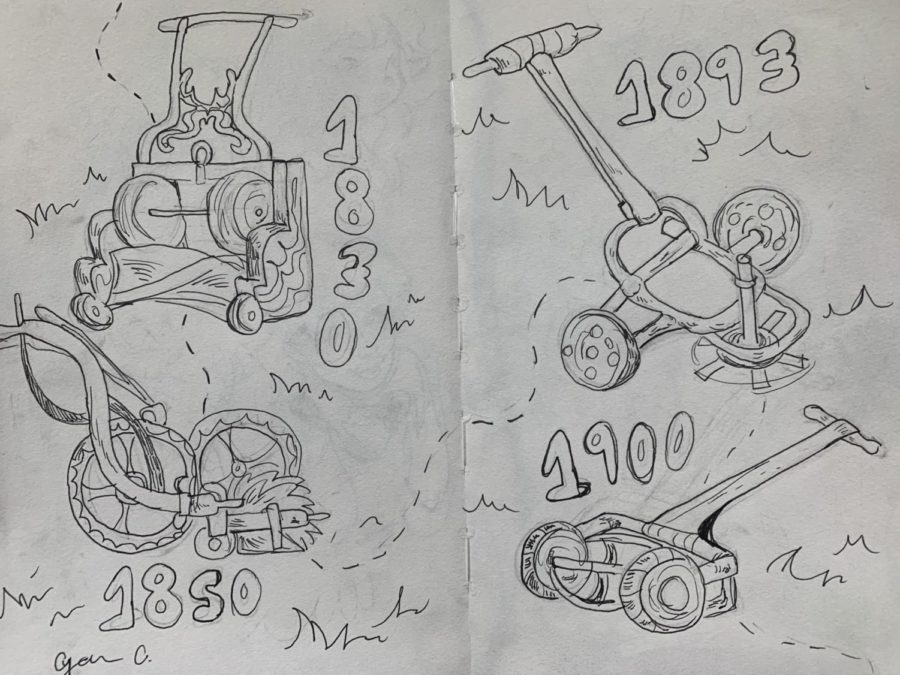Mowing right along: a brief history of lawn mowers
“Lawn Mowers through the Ages” by Cyan Clements
March 17, 2023
The lawn mower, a powerful device and intricate piece of equipment, has been seen, heard of, or perhaps even used, by most of our Gloucester population. Rarely, however, is time taken to reflect on the history, practicality, or structure of these great machines. As we near the two hundredth anniversary of the patenting of the lawn mower, it deserves a bit of celebration.
The first lawn mower was invented just outside Gloucestershire in England by a man named Edwin Beard Budding of Shroud in 1830. The first design was about 19 inches (48 cm) wide, with a wrought-iron frame and cast-iron gear wheels. Similar to many modern designs, the first lawn mower was pushed from behind. The gear wheels transmitted power to the cutting cylinder, allowing the knives on the cutting cylinder to spin.
Regent’s Park Zoological Gardens and the Oxford Colleges were among the first to buy Budding’s earliest designs, both looking for more efficient ways to manage large lawns and properties. After all, the original lawn mower was not meant for the small spaces and meticulous precision some modern tools, such as a “weed whacker” could reach, instead being meant for sports grounds and extensive gardens.
In May of 1830, Edwin Budding collaborated with John Ferrabee to enlarge the blades on the cutting cylinder and increase efficiency further. Along with this collaboration, the two decided to let other companies create lawn mowers under license, including some very successful companies including Ransomes of Ipswich, which began making lawnmowers as early as 1832.
Edwin Budding’s marvelous invention brought him great prosperity, but also improved the sports, leisure, and gardening industries at the time greatly. Sports pitches, playing fields, and sporting ovals were all modernized and kept neatly trimmed, making way for new, codified, and widespread rules and regulations for any sport played on grass. Gardens, cemeteries, and parks were tended faster and with more regularity, increasing visitation.
However, just because Budding had been quick to patent his invention, improvements and other forms of the lawn mower can be seen all the way up to today.
Thomas Green & Son of Leeds introduced a quieter, smoother lawnmower in the 1850s, although this alternative was more expensive than its gear operated predecessor. To create the quieter and lighter weight model, Thomas Green & Son used a chain drive rather than gears to transmit power to the cutting cylinder.
The lawnmower industry truly took off in the 1860s, with a rise in sports and outdoor activity altogether. By 1862 Ferrabee’s company was selling eight models with several roller and cutting cylinder sizes, selling over 5000 before the end of 1863. After the 1860s, there was a brief dip in lawn mower sales before a major improvement led to another boom: the steam-powered lawn mower.
James Sumner of Lancashire patented the first steam-powered lawn mower in 1893. His machine was not perfect, though it was very innovative for its time. It burned petrol and/or kerosene for fuel, and took several hours to warm up to operating pressure, but the steam power paved the way for motorized lawn mowers to come further in the future. The Stott Fertilizer and Insecticide Company of Manchester and Sumner together sold the steam powered lawn mowers as a joint-controlled company called the Leyland Steam Motor Company.
Around 1900 the biggest name in the lawn mower industry was the Ransomes’ Automaton. It sold in both gear and chain driven models, and first started producing their own steam powered mowers in 1902. At about the same time, the first riding mowers were invented, where riders could sit behind animals that pulled larger versions of the machines.
In the United States, gasoline powered lawn mowers were patented in 1914, and this led to the innovations creating what we recognize as a modern lawn mower. In 1922, the first self -propelled, meaning without the need of an animal to pull, riding a lawn mower was patented.
The 1900s brought many innovations, many due to the wars and corresponding economic growth in the United States. These innovations in motors, fuel, plastic, and metal alloys led to the development of lighter weight and more efficient lawn mowers, until eventually the lawn mowers evolved to those of today.































